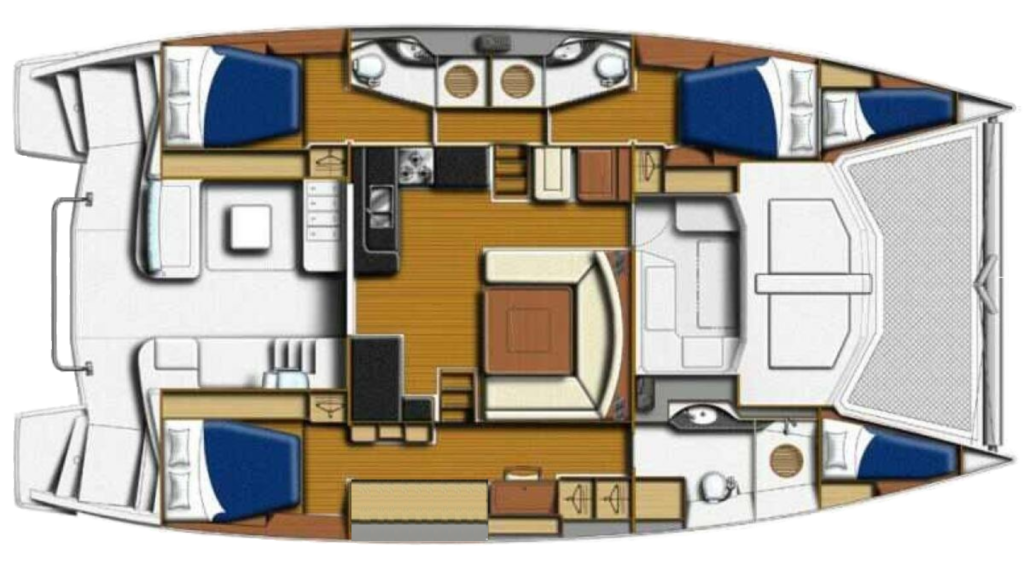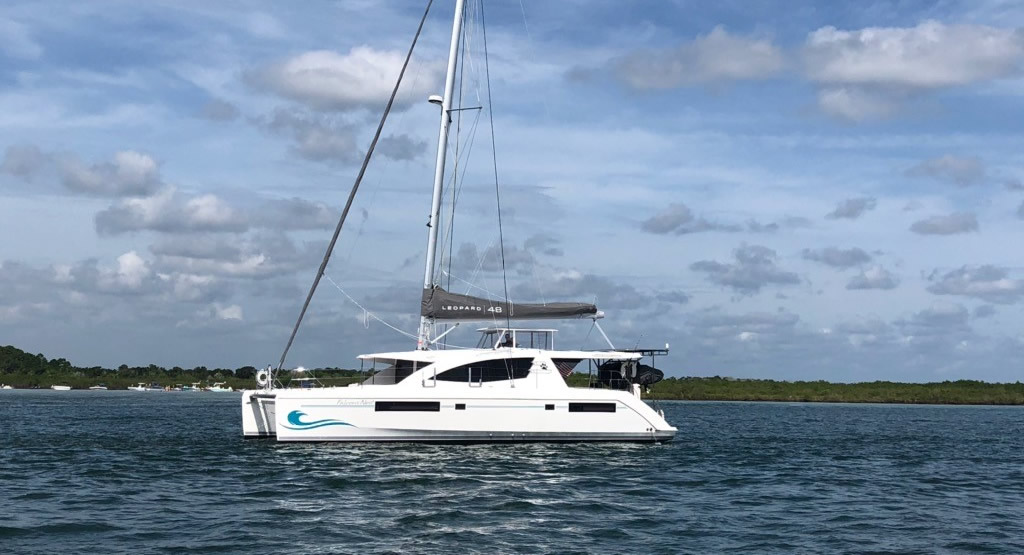The Name
Brian was told over the years that our surname is the anglicized form (think Ellis Island) of the proper German name “Falkenheimer”, which loosely translates to Falcons Haven. No idea if that’s true, but it sounds good! So he’s always adopted various falcon-related nicknames.
When it came time to decide on a boat name, we made up a list of 50 possibilities and then each of us alternated in removing one. The final three were Thunderstruck (the AC/DC song and Brenda’s favorite band), Gypsy (just because we liked it), and Falcons Nest. After having been hit by lightning twice in one year, perhaps we chose the wrong name?
The Boat
Our nest is a late-2017 Leopard 48 sailing catamaran, built by Robertson and Caine in South Africa. It’s what is known as an “owner’s version”, which means there are three cabins (aka bedrooms) instead of the four commonly found in the charter version built for The Moorings. The entire Starboard hull serves as the master cabin. Asrai “The Boss” demanded her own area, as did our noses, so we dedicated the Port-forward head (aka bathroom) to her litter box.

This is the first boat we’ve ever owned and we had very limited sailing experience, unless you count capsizing a Hobie Cat 30 years ago. Knowing we were doing this backwards, we spent over a year researching all the usual questions, such as monohull vs catamaran, manufacturer, and size. From our online work we were leaning towards Leopard, but we needed to see and touch. So we flew across the country to the Miami Boat Show and spent three days inspecting every catamaran there multiple times. It was definitely Leopard for our comfort, performance, sail plan and budget combination. But should we buy new? Those new model 45s look really nice! Or should we buy used? The 48 would provide a little more comfort for a similar price and has been a highly regarded, proven blue water cruising boat. Ultimately, the deciding factor was the belief that the larger size would be more stable and increase the chances that we would actually like our new adventure.
Specs
While our nest came with a number of manufacturer and after-market upgrades, we devoted the first half of 2019 and far too much money to making it ours and truly blue-water ready. The majority of that went into upgrades of our solar and battery capacity.
Getting Around
We had dreams of always sailing and never using our engines. So far, it’s been the opposite. We’re hoping that is because we’ve been limited to the Florida coast and this will change as we get out there.
- Two Diesel Engines
- 57 horsepower Yanmar 4JH57C
- 3 blade Max-Prop folding props (our most recent upgrade)
- 184 US Gallon fuel capacity
- Three Sails (so far)
- Main Sail (fully battened)
- 120% furling Genoa
- A-Symmetrical Spinnaker, an A2 Medium Runner from Precision Sails
Electricity
Electricity is a big topic among cruisers. Boats can get power from any combination of marina plugs, engine alternators, diesel or gas generators, wind generators, hydro generators, and solar. There are pros and cons about all of them, but you’ll often hear people say you should get lithium batteries and as much solar as will fit on your boat. Why?
When we bought Falcons Nest, it came with a 9kW diesel generator. We could run it for many hours before having to worry about refilling our diesel tanks and we could buy a lot of diesel for the $35,000+ it would take to upgrade to lithium and solar. From a purely financial Return-On-Investment perspective, we would never be able to justify it. For us, it’s about freedom. If we were self-sufficient “off the grid”, without the need to consume diesel and propane, we could visit very remote destinations for very long periods of time. We would buy the freedom to not worry about scheduling our next refill. We would buy the freedom to not worry, each and every day, about our battery consumption and if we had surpassed our AGM batteries’ 50% limit. And eliminating the noise is a huge plus.
- 2,006 Watts of Solar
- 1,500W custom stainless steel solar array via four 375W LG rigid glass panels
- 230W via two new 115W walk-on SOLARA Power M panels
- 276W via four original 69W walk-on SunWare panels
- 1,200 Amp Hours of battery via four 300ah 12v Relion Lithium batteries
- 5,000 Watt Victron Quattro inverter/charger
- Victron BMV-712 Smart battery monitor
- Victron Color Control GX to bring all our components together and make all that glorious data available on the internet.
- Northern Lights 9kW diesel generator
We also modified the galley wiring with higher amperage breakers and a new separate circuit so that our induction cooktop and our air fryer could be used at the same time without blowing a breaker. No one wants cold fries with their burger after all!
With this setup, we can use our renewable battery power to run all of our 12V DC and 120V AC plugs, our electrical cooking appliances including induction cooktop, the owner’s cabin air conditioning, the washer/dryer, the water heater, and the water maker. And we typically find that the batteries are back to 100% by noon. We clearly need to stress them more!
Water
Water – the other big topic among cruisers. We are able to make our own water through sea-water reverse-osmosis desalination, which we can power from our batteries. We can also collect gallons of rain water surprisingly fast due to drains in our cabin top. To ensure the water in our tanks is safe to drink, we also added a great little water purifier that fits under the galley sink.
- Watermakers Inc 18 gallon per hour 120V desalination system (ISL-400)
- 206 US Gallons water storage
- Acuva UV-LED water purifier (ARROW 5 with smart faucet)
